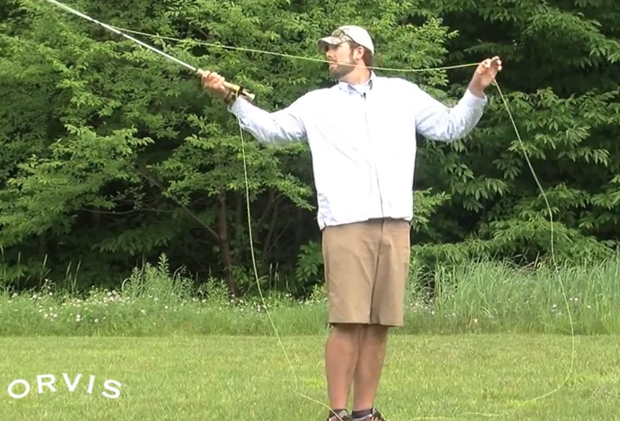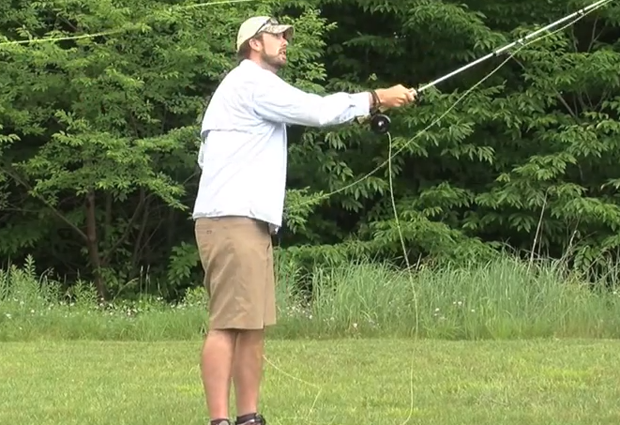” . . . Although we fly cast simply to fish, we may also find that to cast well or better becomes an interest in itself. We will find that achieving greater control through understanding and technique is a very rewarding and satisfying experience, one that also greatly enhances our fly fishing capability and enjoyment of fly fishing.” Robert Gillespie
Double Hauling with the single-handed rod. A haul is a pull on the line with the line hand . . .
[dropcap]I[/dropcap]t is made as a smooth acceleration and not an erratic movement or sudden tug. A double haul is where two separate smooth hauls are made with the line hand to increase line speed during the cast, one haul is made on the second half of the back casting stroke and one haul on the second half of the forward casting stroke.
The hands start off close together, in order to make the second haul, after the first haul on the back casting stroke the hauling hand then has to be returned back up towards the rod hand during the pause (or drifting motion) to allow the loop to form behind. The fly line is fed back smoothly and steadily into the rod rings while tension / tautness is maintained on the line from line momentum generated by the previous back cast and haul as the loop forms and the line is unrolling out behind. The line hand is brought up steadily and slowly so that slack line does not occur and line tension is maintained. A too sudden return of the line hand upwards would throw slack line into the back cast and collapse the forming loop or create shock waves in the fly line.
A second haul can then be made on the forward casting stroke. The fastest part of both hauls should coincide with the fastest rod tip turnover speed. The haul is therefore usually made over the second half of a casting stroke after an initial rod loading movement and some line tautness or tension from rod hand and arm movement has taken place. Hauling may be used with any stance however it is normally practiced with an open stance. Haul length is kept short and is usually 1.5 to 2 feet in length.
The best way to learn double hauling is to learn on some well-mown grass using a side casting stroke. You need to be able to make a narrow loop side cast to either side first without any hauling. Making the side cast using rod tip turnover speed or tip casting from the angle change of the wrist by a controlled wrist break creating the fulcrum pivot. Hauling is an advanced technique and this technique can only be learned after you understand the basic loop forming technique using the rod action with the key exercise in a side cast.

ORVIS fly casting instructor Peter Kutzer demonstrates the double-haul. Here he’s into the back-cast haul. Credit ORVIS video.
You can then learn double-hauling at your own pace building up familiarity with the hauling motion involved a step at a time. Initially use only one back casting stroke or forward casting stroke at a time and stop at the end of each back or forward cast allowing the line to sit on the grass. Do this until the line feed motion after the haul is automatic and your hands are back together each time. Initially the angle will make the haul but forget to make the line feed motion which would return the hands close together. On grass however if the line feed is forgotten to be made, and as we are stopping after each stroke, it only takes a couple of side steps to bring the hands back together and drag the line taut again. Don’t worry; no safety net is required to learn double hauling on grass. You will then, in your own time, eventually remember to do the line feed move on each cast returning the hands together after the haul. Then you will gain enough familiarity with the move to have the confidence to string two casting strokes together to make one complete casting cycle of a back casting stroke with haul, slight pause and line feed, then forward casting stroke and haul without allowing the line to stop and settle on the grass behind.
Once you can keep a couple of casting strokes going without stopping on each stroke to let the line fall on the grass you have a casting cycle. Then you will be able to make a couple of casting cycles through not allowing the line to stop and settle after the forward cast and haul but as the line is almost unrolled out fully in front and line feed was completed then making a back cast and haul of another casting cycle. Soon with familiarity you will then be able to make a few casting cycles without stopping. It is then a simple matter to keep hauling and side casting. You will then be able to raise up the rod to a more vertical plane as you are hauling and change your stance to an open stance and face the direction of the forward cast.
Is familiarity with the hauling movement double hauling completely sorted then? No, the arms alone will only take a person so far in casting distance using the double haul. Perfectly fine for most fishing situations. However, to go for greater distances again then it will be necessary to use simultaneous body movement from weight shift and weight transfer with a longer casting stroke.
[information]
Feature story source: Fly Casting Matters / Real World Fly-Casting / Robert Gillespie
A good aid to learning the double haul is the word downup – it is one word and possibly invented by Mel Kreiger. His video is . . .
A more current presentation of the downup double-haul is from ORVIS . . .
[youtube id=”d8idd4kgXY4″ width=”620″ height=”360″]
[/information]







